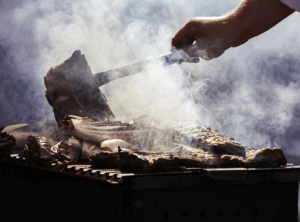The Science Behind Smoking Meat
 Smoking meat is not only an art form, but there is a science to it. Throughout the process of smoking, meat is tenderized, the flavor is added, and your food is transformed. But how? Magic? Well, we like to think so. However, when it comes to barbecue, there is indeed a science behind smoking meat.
Smoking meat is not only an art form, but there is a science to it. Throughout the process of smoking, meat is tenderized, the flavor is added, and your food is transformed. But how? Magic? Well, we like to think so. However, when it comes to barbecue, there is indeed a science behind smoking meat.
Basic Meat Science
When cooking meat, there are physical and chemical changes happening. It is called denaturing. It is a complex process, but basically, it is when proteins or nucleic acids lose the structure of their native state. In addition, the browning of the meat happens due to the Maillard reaction. That is when amino acids react with reducing sugars to form – you guessed it – the brown color.
Fun fact, it wasn’t until the 1940s that people realized that the browning of food and the flavor had a connection. Scientists actually studied this for the couple decades. Amongst the many things they learned, beef has as many as 600 components in its aroma! Yum!
There is more to the history and science behind smoking meat, but what is so different about smoking meat?
The Smoking Meat Difference
For starters, smoking meat takes patience. At Chad’s, we appreciate the wait for good tasting food. We also know you can’t simply put wet wood chips over coals and call it smoking meat. While it may add flavor to the outside, fully smoking your food really helps to develop flavors much deeper in the meat.
The main factor in smoking meat, compared to barbecuing or grilling, is the temperature.
- Smoking: Almost no heat, 52° – 140° F (12° – 60° C)
- Barbecuing: Low heat, 200° – 300° F (93°-150° C)
- Grilling: high heat, 500° F (200° C)
Grilling quickly traps the juices by creating a crust on the outside. Barbecuing varies, based on where you live. It can change between cooking with high temps like grilling, to lower temps like smoking.
Smoking Necessities
So, interested in smoking? We will cover specifics in later posts but here is a list to get you started:
- Smoker: Need one. You can sometimes use a grill as a smoker too. In the end, you really need to do your homework to find the best smoker for you.
- Wood: Smokers can vary the taste of the meat as much as the wood used can too. Check out our blog to see the difference wood can make.
- Meat: The type of meat that you choose to smoke depends greatly on taste. The most popular meats smoked by fanatics include ribs, pork shoulder, and brisket.
Remember, in addition to the science behind smoking meat, smoking is also an art where patience and practice are needed. If you rather, just stop into Chad’s and check out our menu. If you have ideas or questions you would like us to cover on our blog, let us know on Facebook.
Share